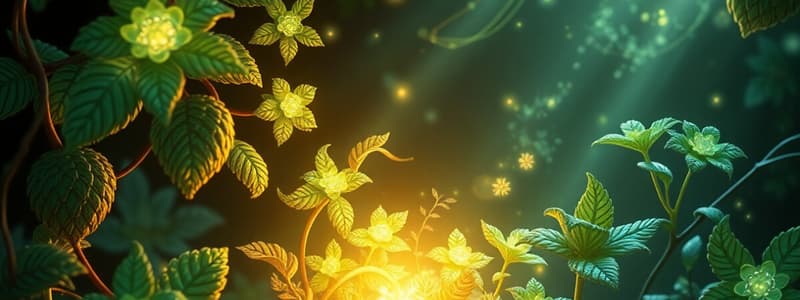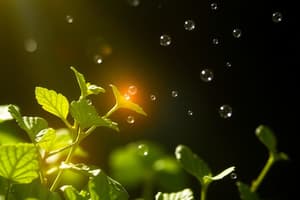Podcast
Questions and Answers
What is the primary function of triose phosphate molecules produced in photosynthesis?
What is the primary function of triose phosphate molecules produced in photosynthesis?
- To synthesize cellulose for cell walls.
- To be used directly as energy sources for the plant.
- To regenerate ribulose bisphosphate. (correct)
- To form amino acids used in protein synthesis.
How are carbohydrates such as sucrose synthesized in plants?
How are carbohydrates such as sucrose synthesized in plants?
- From the polymerization of ribulose bisphosphate.
- By extracting them from the soil.
- By converting fatty acids directly into sugars.
- Through the combination of glucose and fructose. (correct)
What are lipids in plant cells primarily composed of?
What are lipids in plant cells primarily composed of?
- Glycerol and fatty acids. (correct)
- Starch and cellulose.
- Triglycerides and amino acids.
- Carbohydrates and proteins.
Which compound is used by plants to begin the synthesis of proteins?
Which compound is used by plants to begin the synthesis of proteins?
What role do starch and cellulose serve in plants?
What role do starch and cellulose serve in plants?
What is the main purpose of photophosphorylation in photosynthesis?
What is the main purpose of photophosphorylation in photosynthesis?
Which process involves the splitting of water molecules during photosynthesis?
Which process involves the splitting of water molecules during photosynthesis?
What occurs when chlorophyll molecules are photoactivated?
What occurs when chlorophyll molecules are photoactivated?
What happens to the electrons that are raised to an excited state in cyclic photophosphorylation?
What happens to the electrons that are raised to an excited state in cyclic photophosphorylation?
What is the role of electron carriers during the light-dependent reactions?
What is the role of electron carriers during the light-dependent reactions?
Which of the following is true about ATP synthesis during the light-dependent stage?
Which of the following is true about ATP synthesis during the light-dependent stage?
What distinguishes cyclic from non-cyclic photophosphorylation?
What distinguishes cyclic from non-cyclic photophosphorylation?
What role does ATP play in guard cells?
What role does ATP play in guard cells?
What is the source of electrons that replace those lost from chlorophyll in photosystem II?
What is the source of electrons that replace those lost from chlorophyll in photosystem II?
Which compound is reduced during non-cyclic photophosphorylation?
Which compound is reduced during non-cyclic photophosphorylation?
What is the primary function of the proton gradient built in the thylakoid lumen?
What is the primary function of the proton gradient built in the thylakoid lumen?
Which of the following best describes photolysis?
Which of the following best describes photolysis?
What does ADP convert into during the light-dependent stage, when electrons lose energy?
What does ADP convert into during the light-dependent stage, when electrons lose energy?
What happens to the three-carbon glycerate 3-phosphate (GP) during the Calvin cycle?
What happens to the three-carbon glycerate 3-phosphate (GP) during the Calvin cycle?
During the Calvin cycle, which enzyme catalyzes the reaction between carbon dioxide and ribulose bisphosphate (RuBP)?
During the Calvin cycle, which enzyme catalyzes the reaction between carbon dioxide and ribulose bisphosphate (RuBP)?
What are the products of the light-dependent reactions of photosynthesis?
What are the products of the light-dependent reactions of photosynthesis?
What characterizes cyclic photophosphorylation?
What characterizes cyclic photophosphorylation?
Flashcards
Light-Dependent Stage
Light-Dependent Stage
The initial stage of photosynthesis where light energy is captured and used to synthesize ATP and reduced NADP.
Where does the Light-Dependent Stage occur?
Where does the Light-Dependent Stage occur?
Occurs in the thylakoid membranes of chloroplasts, involving the capture of light energy for two purposes: photophosphorylation and photolysis.
Photophosphorylation
Photophosphorylation
Process of adding an inorganic phosphate molecule (Pi) to ADP to produce ATP using light energy.
Photolysis
Photolysis
Signup and view all the flashcards
Electron Transport Chain in Light-Dependent Stage
Electron Transport Chain in Light-Dependent Stage
Signup and view all the flashcards
Chemiosmosis
Chemiosmosis
Signup and view all the flashcards
Light-Independent Stage (Calvin Cycle)
Light-Independent Stage (Calvin Cycle)
Signup and view all the flashcards
Rubisco
Rubisco
Signup and view all the flashcards
Calvin Cycle Steps
Calvin Cycle Steps
Signup and view all the flashcards
RuBP
RuBP
Signup and view all the flashcards
Reduced NADP
Reduced NADP
Signup and view all the flashcards
Cyclic Photophosphorylation
Cyclic Photophosphorylation
Signup and view all the flashcards
Non-Cyclic Photophosphorylation
Non-Cyclic Photophosphorylation
Signup and view all the flashcards
Photoactivation of Chlorophyll
Photoactivation of Chlorophyll
Signup and view all the flashcards
Z-Scheme
Z-Scheme
Signup and view all the flashcards
Oxygen-Evolving Complex
Oxygen-Evolving Complex
Signup and view all the flashcards
GP (Glycerate 3-Phosphate)
GP (Glycerate 3-Phosphate)
Signup and view all the flashcards
TP (Triose Phosphate)
TP (Triose Phosphate)
Signup and view all the flashcards
Hexose Sugar
Hexose Sugar
Signup and view all the flashcards
Starch
Starch
Signup and view all the flashcards
Cellulose
Cellulose
Signup and view all the flashcards
Formation of other substances
Formation of other substances
Signup and view all the flashcards
Study Notes
Light Dependent Stage of Photosynthesis
- Occurs in the thylakoids of chloroplasts.
- Involves capture of light energy for two purposes:
- Photophosphorylation: adding an inorganic phosphate molecule to ADP to make ATP.
- Photolysis: splitting water into protons, electrons, and oxygen.
- Photoactivation of chlorophyll: light energy raises the energy level of electrons in chlorophyll molecules.
- Excited electrons are taken up by electron carriers/acceptors, oxidizing the chlorophyll molecule and reducing the carrier.
- Electrons are passed along a series of electron carriers in redox reactions.
- Energy released is used to transfer protons across the thylakoid membrane into the thylakoid space (lumen).
- Proton gradient drives ATP production via chemiosmosis.
Cyclic Photophosphorylation
- Uses photosystem I only.
- Excited electrons are taken up by an electron acceptor and passed back to the same chlorophyll molecule via electron carriers (recycling).
- Produces ATP, but not reduced NADP.
- ATP is used in the light independent stage or for specific functions like stomatal opening.
Non-Cyclic Photophosphorylation
- Uses both photosystem I and II.
- Excited electrons from PSII are passed to PS I via electron carriers.
- Excited electrons from PSI are taken up by NADP+ to form reduced NADP (NADPH + H+).
- Electrons lost in PSII are replaced by electrons from water molecules split by photolysis.
- Photolysis also contributes protons to the thylakoid lumen, increasing the proton gradient.
- Reduced NADP is used in the light-independent stage to reduce carbon dioxide.
Photolysis
- Splitting of water molecules using light energy.
- Occurs only in PSII, associated with the oxygen-evolving complex.
- Produces protons, electrons, and oxygen (O2).
- Electrons replace those lost in PSII, while protons contribute to the proton gradient.
The Z-Scheme
- Illustrates the zig-zag energy levels of electrons during the light-dependent stage.
- Light energy is trapped by PSII, boosting electrons to a higher energy level.
- Electrons are passed to an electron acceptor and then along a chain of carriers to PSI, releasing energy for ATP production.
- Light energy absorbed by PSI further excites the electrons.
- Excited electrons from PSI are taken up by another electron acceptor and then used to reduce NADP+.
- Some electrons may return to PSI via electron carriers, resulting in cyclic photophosphorylation and ATP production.
Light Independent Stage of Photosynthesis (Calvin Cycle)
- Occurs in the stroma of chloroplasts.
- Does not require light directly, but needs the products from the light-dependent stage.
- Details worked out by Melvin Calvin and colleagues.
- Steps:
- CO2 diffuses into the leaf and dissolves in water around palisade cells.
- CO2 combines with RuBP (ribulose bisphosphate) using the enzyme rubisco, forming an unstable 6-carbon compound.
- The unstable compound splits into two molecules of GP (glycerate 3-phosphate).
- ATP from the light-dependent stage is used to convert GP to TP (triose phosphate).
- Reduced NADP (from the light-dependent stage) provides hydrogen for the reduction of GP to TP.
- TP molecules combine in pairs to form 6-carbon (hexose) sugars.
- Glucose can be further polymerized into starch or cellulose.
- Five out of six TP molecules are used to regenerate RuBP, using ATP from the light-dependent stage.
Formation of Other Substances in Plants
- Plants synthesize carbohydrates, lipids, and proteins.
- Carbohydrates:
- Sucrose (transport sugar) is made from glucose and fructose.
- Starch (storage) and cellulose (cell wall) are made by polymerizing glucose.
- Lipids:
- Glycerol is made from triose phosphate.
- Fatty acids are made from GP.
- Lipids are used for storage and phospholipids in cell membranes.
- Proteins:
- Amino acids are produced from GP via acetyl coenzyme A and Krebs cycle intermediates.
- Proteins are essential components of cell membranes and enzymes.
Studying That Suits You
Use AI to generate personalized quizzes and flashcards to suit your learning preferences.



